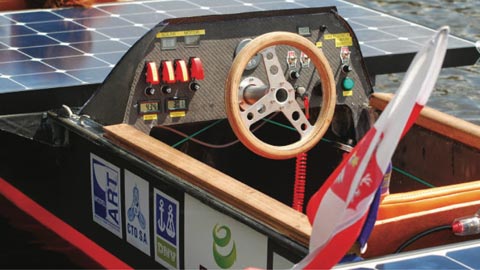Design parametric 3D models of individual elements
Design parametric 3D models of individual elements

Case Study
Gdańsk University of Technology uses Siemens Digital Industries Software solution to teach cutting-edge skills in boat design
Gdańsk University of Technology
University uses NX to shine in solar boat competition and make students more attractive to potential employers
Making history
In the autumn of 2005, the faculty members of Ocean Engineering and Ship Technology at Gdańsk University of Technology set out to break the mold in boat building by taking part in the Frisian Solar Challenge, the first edition of exclusively solar-powered boat races, which were to take place in 2006 in the Netherlands.
Back then solar boats were not very popular in Poland, or elsewhere for that matter. At the time, applying photovoltaics to mobile objects did not go beyond experimentation. The first solar boat race took place in Germany in the 1980s. The initiative was then taken over by the Dutch, who managed to build up the prestige of this event.
A successful debut
The KORAB Students Scientific Association received a grant of 10,000 PLN (Polish zloty) from Professor Janusz Rachoń, then rector of the university, to build the boat.
“This was not an overwhelming amount so in order to make this project happen and then transport it to the Netherlands with the entire crew, we needed additional funding,” says Dr. Wojciech Litwin, the tutor of the scientific association, and associate dean for science of the faculty of ocean engineering and ship technology. “What we managed to collect was not enough. The price of photovoltaic panels was so steep that the prototype of the boat, which we built in a few months, sailed with mock panels made of plywood.”
The panels were lent to the Poles by the organizers of the Frisian Solar Challenge only after they reached the event site.
During its first race the boat built by the Polish students and scientists came in fifth, which was a major success. The students’ technical specification document consisted of a few dozen pages. It specified the size of the boat, its draught, height, safety issues, stability and protective measures.
“There is a certain space available on which you can mount a permitted number of photovoltaic panels,” says Litwin. “In the standard class races that we compete in, these are normal panels that you can find on land structures covered with glass in an aluminium frame. Each weighs about 15 kilograms (kg) and you need to install four to five panels, each with 200 watts (W) of power, depending if it is a one-or-two person boat.”
Winning software
The Polish racing team, the Gdańsk University of Technology (GUT) – SOLAR, currently uses third-generation boats. It would be impossible to build them without an adequate preparatory process. The first boat that was launched in 2006 was mostly homemade; the designers used a standard drawing board, pencil, calculator and only rarely employed a computer. In 2010, KORAB prepared the first two-person boat that was launched in the Netherlands, and it proved to be highly competitive. The winning boat was designed using Solid Edge® softwarefrom Siemens Digital Industries Software. Initially, Solid Edge was used to design parametric 3D models of individual elements and assemblies as well as prepare a comprehensive technical drawings package. It would be impossible now to imagine a designer (of almost any product, including boats) working without a computer-aided design (CAD) system.
No wonder Litwin is so fascinated with this software: “When I was a student 20 years ago, universities did not sign contracts with software developers,” he explains, looking back on his projects as well as the designing process used with the first boat. “Today students can learn how to operate cutting-edge software as members of various scientific associations or even individually at home. Because of that the software can be used both during classes and in projects implemented by scientific circles.”
What’s more, Siemens Digital Industries Software permits students and faculty to install software on their private computers, which means they can use it any time they want, not only several hours a week during class.
